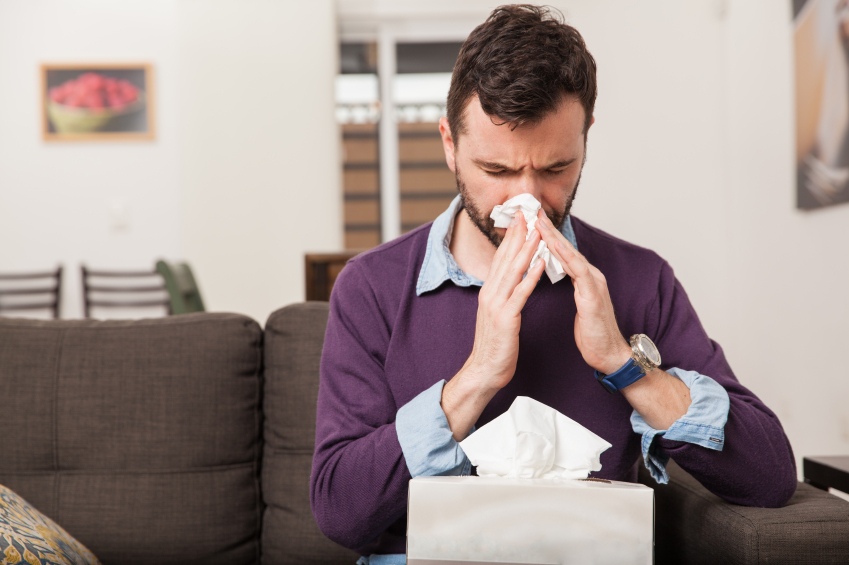Indoor Allergies Treatment Chicago
Indoor Allergens
 Millions of people suffer year-round from allergy symptoms caused by indoor allergens. These culprits include dust mite droppings, animal dander, cockroach droppings and molds.
Millions of people suffer year-round from allergy symptoms caused by indoor allergens. These culprits include dust mite droppings, animal dander, cockroach droppings and molds.
Your immune system controls how your body defends itself. For instance, if you have an allergy to dust mites, your immune system identifies dust mites as an invader or allergen. Your immune system overreacts by producing allergic antibodies called Immunoglobulin E (IgE). These antibodies travel to cells that release chemicals, causing an allergic reaction. This reaction usually causes symptoms such as sneezing, stuffiness, a runny nose, or itchiness in your nose, the roof of your mouth, throat, eyes or ears.
When these symptoms occur year-round, the condition is called perennial allergic rhinitis. In addition to causing allergy symptoms, allergens can also trigger asthma flare ups in people with allergic asthma.
With the help of an allergist / immunologist, often referred to as an allergist, you can learn what allergens cause your symptoms. While avoiding allergens is the most effective treatment approach, strict avoidance isn’t always possible. Here are some changes you can make to help you feel better.
Dust Mites
Dust mite allergens are a common trigger of allergy and asthma symptoms. While they can be found throughout the house, these microscopic creatures thrive in warm, humid environments such as bedding, upholstered furniture and carpeting.
Because so much time is spent in the bedroom, it is essential to reduce mite levels there. Encase mattresses, box springs and pillows in special allergen-proof fabric covers or airtight, zippered plastic covers. Bedding should be washed weekly in hot water (130° F) and dried in a hot dryer. Allergen-proof covers are available for comforters and pillows that can’t be regularly washed.
Keep humidity low by using a dehumidifier or air conditioning. Wall-to-wall carpeting should be removed as much as possible. Instead, throw rugs may be used if they are regularly washed or dry cleaned.
Pet Allergens
Contrary to popular opinion, there are no “hypoallergenic” breeds of dogs or cats. That is because people are not allergic to an animal’s hair, but to an allergen found in the saliva, dander (dead skin flakes) or urine of an animal with fur.
Pet allergy symptoms typically occur within minutes. For some people, symptoms build and become most severe 8 to 12 hours after contact with the animal. People with severe allergies can experience reactions in public places if dander has been transported on pet owners’ clothing.
Keeping an animal outdoors is only a partial solution, since homes with pets in the yard still have higher concentrations of animal allergens.
Before getting a pet, ask your allergist to determine if you are allergic to animals. If your pet is already considered part of your family, try to minimize contact and keep the pet out of the bedroom and other rooms where you spend a great deal of time. As with dust mites, vacuum carpets often or replace carpet with a hardwood floor, tile or linoleum.
While dander and saliva are the source of cat and dog allergens, urine is the source of allergens from rabbits, hamsters, mice and guinea pigs; so ask a non-allergic family member to clean the animal’s cage.
If you have a pet allergy, talk to your allergist about the potential for allergy immunotherapy (allergy shots). This strategy can often provide long-term relief.
Cockroaches
Cockroaches are often found in the homes of densely populated urban areas, schools or commercial buildings, but these creatures can lurk almost anywhere. This does not mean that you have a dirty house or living area.
Block all areas where roaches can enter the home. This includes crevices, wall cracks and windows. Cockroaches need water to survive, so fix and seal all leaky faucets and pipes. Have an exterminator go through the house when your family and pets are gone to eliminate any remaining roaches.
Keep food in lidded containers and put pet food dishes away after your pets are done eating. Vacuum and sweep the floor after meals, and take out garbage and recyclables. Use lidded garbage containers in the kitchen. Wash dishes immediately after use and clean under stoves, refrigerators or toasters where crumbs can accumulate. Wipe off the stove and other kitchen surfaces and cupboards regularly.
Indoor Molds
Indoor molds and mildew need dampness typically found in basements, bathrooms or anywhere with leaks. Get rid of mold growth on hard surfaces with water, detergent and, if necessary, 5% bleach (do not mix with other cleaners). Then dry the area completely. If mold covers an area more than 10 square feet, consider hiring an indoor environmental professional. For clothing, washing with soap and water is best. If moldy items cannot be cleaned and dried, throw them away.
Repair and seal leaking roofs or pipes. Using dehumidifiers in damp basements may be helpful, but empty the water and clean units regularly to prevent mildew from forming. All rooms, especially basements, bathrooms and kitchens, require ventilation and cleaning to deter mold and mildew growth. Avoid carpeting on concrete or damp floors, and storing items in damp areas.
Healthy Tips
- Allergic rhinitis symptoms can occur in the nose, lungs, throat, sinuses, ears and eyes.
- Your allergist can help you identify things in your home, workplace or school that make your symptoms worse.
- Allergens can trigger asthma symptoms in people with allergic asthma.
- Avoiding allergens that cause symptoms is the most effective way to treat symptoms.
Feel Better. Live Better.
An allergist / immunologist, often referred to as an allergist, is a pediatrician or internist with at least two additional years of specialized training in the diagnosis and treatment of allergies, asthma, immune deficiencies and other immunologic diseases.
By visiting the office of an allergist, you can expect an accurate diagnosis, a treatment plan that works and educational information to help you manage your disease and feel better.
The AAAAI's Find an Allergist / Immunologist service is a trusted resource to help you find a specialist close to home.
Video: What are indoor allergens?
Source: AAAAI




